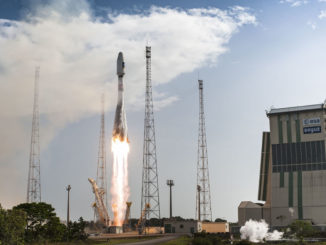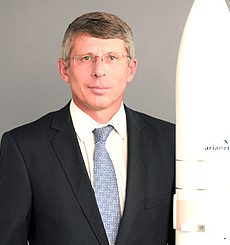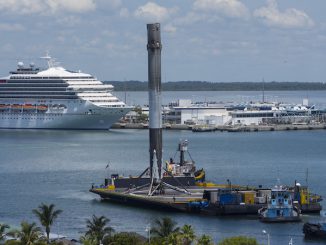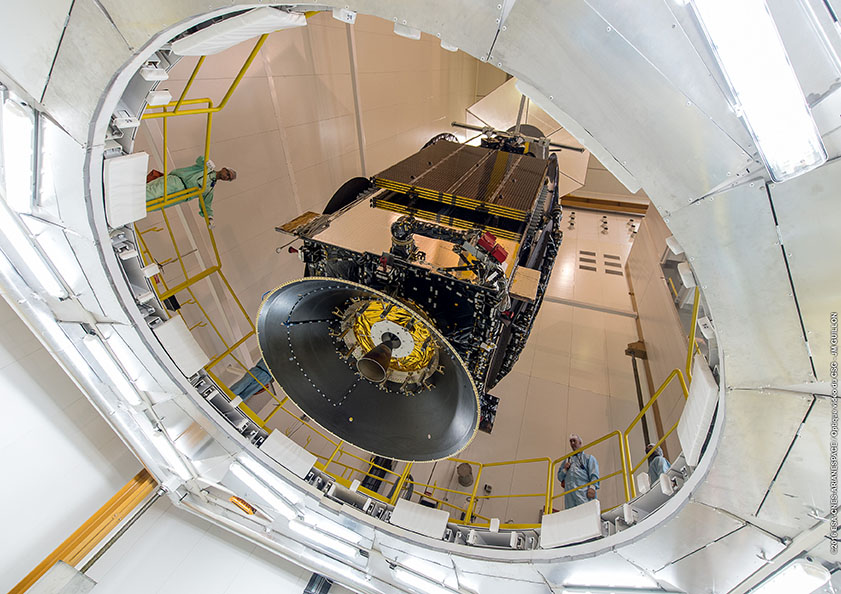
A new communications satellite to beam television channels to millions of DISH Network subscribers in the United States and the first spacecraft dedicated to support banking services have been attached to an Ariane 5 rocket for liftoff June 8 from French Guiana.
The dual-satellite mission will loft the heaviest payload ever launched by an Ariane 5 rocket to geostationary transfer orbit, a highly elliptical loop around Earth commonly used as a drop-off location for telecom spacecraft heading for operating posts more than 22,000 miles (about 35,700 kilometers) over the equator, where they hover over fixed locations on the planet.
Liftoff from the equatorial launch base is scheduled for 2030 GMT (4:30 p.m. EDT; 5:30 p.m. French Guiana time) on June 8 at the opening of a 45-minute launch window, according to Arianespace, the Ariane 5’s commercial operator.
The EchoStar 18 satellite, fitted with a direct-to-home broadcast payload, is the larger of the two payloads launching on Ariane 5 next week. It will ride in the upper position in the rocket’s nose fairing.
The BRIsat spacecraft is in the lower deck of the Ariane 5’s payload composite, beginning a mission for Bank Rakyat Indonesia, which plans to use the satellite to link its remote banking terminals spread across the country’s many islands.

Both satellites were manufactured in Palo Alto, California, by Space Systems/Loral, and are based on the company’s 1300 series platform.
EchoStar 18 arrived first at the Guiana Space Center aboard an Antonov An-124 cargo plane on April 20, and technicians wearing special hazmat suits filled the craft with toxic in-space maneuvering propellant from May 4 to May 9. Ground crews transferred the spacecraft from its processing clean room across the tropical spaceport to the Ariane 5’s final assembly building May 12, where EchoStar 18 was connected with the rocket’s barrel-shaped Sylda dual-payload adapter the next day.
On May 14, the Ariane 5’s 5.4-meter diameter (17.7-foot) payload fairing was installed around EchoStar 18, creating a composite with the nose cone, satellite and Sylda adapter in one unit.
In the meantime, BRIsat arrived in French Guiana on May 9 on another Antonov An-124 transport aircraft. BRIsat was fueled from May 23 to May 25 with its own supply of propellants.
Ground teams moved the BRIsat satellite to the Ariane 5 final assembly building May 27, then hoisted it atop the rocket’s second stage Monday. The launcher was topped out Tuesday, when workers lowered the payload fairing — with EchoStar 18 and the Sylda structure, over BRIsat.
With both satellites in position for next week’s launch, the Ariane 5 stands nearly 55 meters (180 feet) tall.
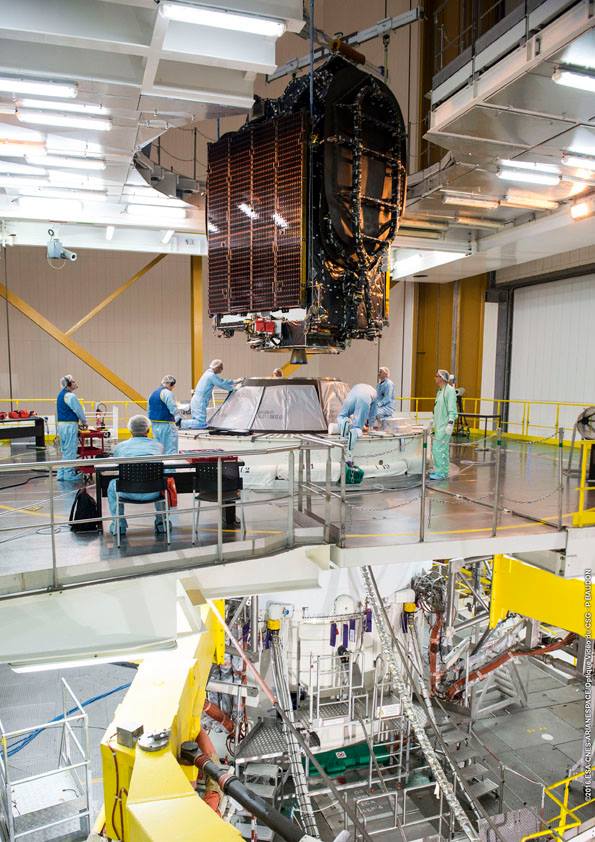
The Ariane 5 rocket is tailored to carry two satellites per flight, allowing customers to share launch costs.
Heavier spacecraft have flown aboard Ariane 5 rockets before — such as the European Space Agency’s Automated Transfer Vehicles for the International Space Station — but the sum of EchoStar 18 and BRIsat on next week’s mission will mark the heaviest commercial payload ever shot into space on Europe’s workhorse rocket.
EchoStar 18 weighs approximately 6.3 metric tons (13,889 pounds) fully fueled, while BRIsat’s launch weight is 3,540 kilograms (7,804 pounds), totaling more than 9,840 kilograms (21,693 pounds).
That will be the heaviest unclassified payload ever delivered to geostationary transfer orbit.
When accounting for the weight of the rocket’s Sylda payload adapter structure, the total mass allocated to the payload on next week’s launch is 10,731 kilograms (23,657 pounds), according to Arianespace.
The Ariane 5 rocket next week will target an orbit ranging from 250 kilometers (155 miles) to 35,766 kilometers (22,224 miles), with a tilt of 6 degrees to the equator.
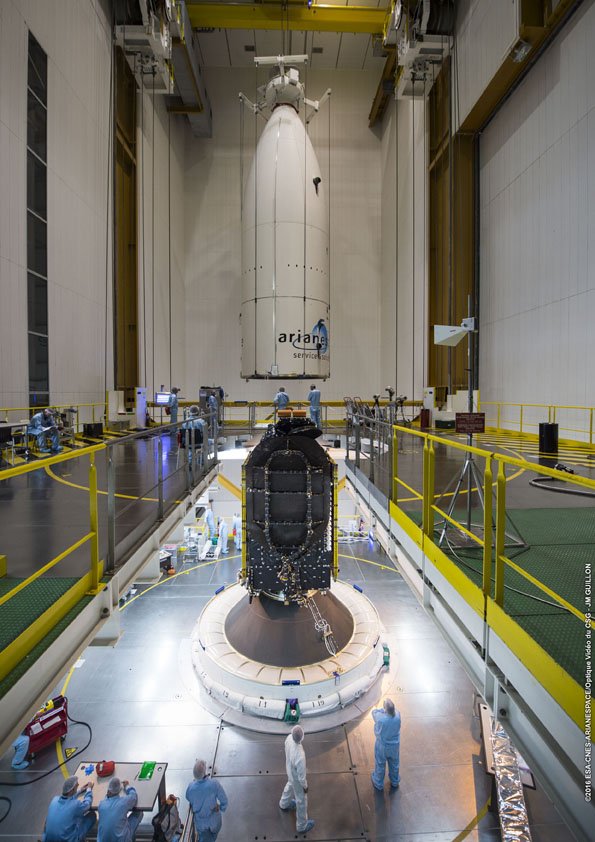
Launch preps at the spaceport in Kourou, French Guiana, continue this week with a launch rehearsal planned for Thursday, followed on Friday by arming of the Ariane 5’s pyrotechnic systems.
A launch readiness review is scheduled for Monday, when managers from Arianespace, the satellite owners and the French space agency CNES — the operator of the range at the space center — convene to discuss the status of launch preparations.
If officials give the green light for launch, the Ariane 5 rocket will roll out of its final assembly building Tuesday morning for a 2.7-kilometer (1.7-mile) trip to the launch pad.
The launch team will load cryogenic propellants into the Ariane 5’s first and second stages Wednesday, aiming for liftoff about one hour before sunset.
Next week’s flight will be the 230th launch for the Ariane rocket family since 1979, and the 86th launch by an Ariane 5 rocket since 1996.
Email the author.
Follow Stephen Clark on Twitter: @StephenClark1.

